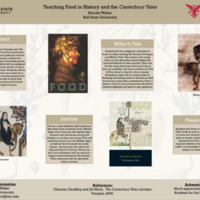Browse Exhibits (81 total)
Alijah Forbes | The Effects of Agreeableness and Political Orientation on Perceptions of Aggression in Media
Research on aggression in media is often focused on the aggression’s influence of later aggressive acts. One area that is often not researched is the perceptions of these aggressive acts, and how they are influenced. Prior research on influences on perceptions have shown that they can be influenced by ingroup bias (Hastorf & Cantril,1954; Kim, 2016) and differences in personality (Costa & McCrae, 1986). These areas of research can be tied together in order to look at the differences of perceptions of aggressive acts and how they are influenced, specifically looking at political ideology and agreeableness. This is the focus of the present study, by seeing how the differences of political ideology and agreeableness affect how individuals perceive acts of aggression. The acts of aggression that will be focused on are video media of interactions between police and protestors during a Black Lives Matter protest.
Faculty Mentor: Dr. Thomas Holtgraves
Psychological Science
Undergraduate
Honors College
Allen Warren | Life's a Peach: The Convergence of Sexuality and Class in Guadagnino's Call Me by Your Name
Call Me by Your Name (2017) became famous for its “peach scene,” though the orchard around the Perlmans’ villa where this fruit thrives could not have grown on its own. Distinctions of class and a parasitism by the most affluent of their workers cultivate the paradise where director Luca Guadagnino sets the blossoming romance between Elio and Oliver. Apricots are a clear metaphor for desire here, yet their prolificacy is only possible through the invisibility and silent intervention of other food items, from peas to latkes to water. Critics have pointed out the beauty of the Italian setting and its use as a temporary escape from heteronormative surveillance, as well as the way domestic workers flow in and out of scenes almost wordlessly. What these critics have missed is the connection these occurrences have in explaining how the working class have built (butdo not benefit from) this heaven on Earth, where the young male lovers may permit their bodies to act without restraint. While queer and class theories inform this discussion, my primary vehicle for interpretation will be food, both for its prominent place in the movie and for the ways it parallels the class structure at the villa. I find the film quietly reflects on the levels of economic privilege and exploitation needed to experience the paradise it depicts, with the usurpation of food in many scenes helping to remind the audience of the inability of this space to be wholly subversive.
Faculty Mentor: Dr. Emily Rutter
Department of English
Undergraduate
Anna Himes | Trait Anxiety and Assessment of Ambiguous Emotions
The purpose of the current study is to examine whether trait anxiety affects participants’ ability to recognize facial emotions. Past research has supported the notion that high levels of anxiety may result in an inaccurate recognition of emotion. Specifically, possibly through mechanisms such as the Facial Feedback Hypothesis and Embodied Emotion Simulation, past research has supported the notion that individuals with anxiety are more likely to misclassify nonthreatening emotions as threatening. However, there has yet to be a robust set of studies that observe this relationship with the added factor of ambiguity created by surgical masks. In this study, college students completed a trait anxiety measure and emotion-recognition task consisting of 56 photographs of Black and White males and females who were expressing anger, fear, disgust, happiness, calm, sadness, or neutrality. Half of the photographs included surgical masks covering the bottom half of the person’s face. Three hypotheses were tested: Participants with higher trait anxiety will be less accurate at identifying masked and unmasked emotions than participants with lower trait anxiety overall; Participants with high trait anxiety will misclassify non-threatening masked and unmasked emotions (happy, calm, neutral) as threatening emotions (anger, disgust, fear) more often than participants with low trait-anxiety; and participants with high and with low trait anxiety will perform more accurately in assessing unmasked emotions than in assessing masked emotions.
Faculty Mentor: Dr. Kristin Ritchey
Department of Psychological Sciences
Undergraduate
Honors College
Audrey Hasser | The Relationship of Parental Communication and Emerging Adulthood Risky Behaviors of Binge Drinking and Vaping
Past research regarding parental communication and risk-taking behaviors largely focuses on risk-taking behaviors happening during adolescence, more specifically, the focus has largely been on sexual risk-taking behaviors. The current research examines this relationship of quality parental communication and risk-taking behaviors but shifts the focus to risk-taking behaviors happening in a different developmental period—emerging adulthood. The risk-taking behaviors examined in the present study are risky drinking behaviors, such as binge drinking and the risk taking behavior of vaping, as they have not been extensively researched in the past. The present study’s objective was to determine whether quality parental communication happening during adolescence would be related to risk-taking behaviors happening in emerging adulthood. Specifically, it was hypothesized that quality parent-adolescent communication would have a negative relationship with both alcohol use and the use of electronic cigarettes during emerging adulthood. Participants completed measures of parent-adolescent communication as well as measures regarding their current drinking and vaping habits and correlation and regression analysis were conducted. The results of these analysis indicated that quality parental communication during adolescence had a significant negative correlation with alcohol use in emerging adulthood but no correlation was found for quality parental communication and vaping habits.
Faculty mentor: Anjolii Diaz
Department of Psychological Science
Undergraduate
Honors College
Bobbie Burton | The Effects of Moral and Pragmatic Reasons for Diversity on Institutional Trust and Organizational Commitment
This study examines how an organization’s decision to implement a diversity program affects people’s perceptions of the organization. More specifically, is a simple commitment to diversity enough to elicit institutional trust and organizational commitment from its members, or do trust and commitment depend upon the motive for adopting the initiative? Specifically, this study focuses on moral motives (“It’s the right thing to do”) as compared to pragmatic motives (“It’s the practical thing to do”). Adapted versions of the Affective Commitment Scale (Meyer & Allen, 1990) and the Trust in Organization Scale (Robinson, 1996) are used to measure organizational commitment and institutional trust. Participants are randomly assigned to one of three conditions in which they are tasked with reading 1) a hypothetical policy that supports diversity implementation for a moral reason, 2) a hypothetical policy that supports diversity implementation for a pragmatic reason, or 3) a hypothetical policy unrelated to diversity. Participants are asked to answer questions about their perceptions of the organization’s decision and motives, as well as their support for the proposed hypothetical policy. It is expected that a moral motive for diversity implementation will elicit greater organizational commitment and trust than a pragmatic motive.
Faculty Mentor: Dr. Andrew Luttrell
Department of Psychological Science
Undergraduate
Honors College
Brevin Wittmer, Collin Steiner, Evan Mitchell, Nick D'Agostino | Regalia Share Application

Regalia Share is a web-based application that allows Ball State University faculty to loan and borrow various pieces of Regalia to help foster a greater sense of community.
Faculty Mentor: Huseyin Ergin
Department of Computer Science
Undergraduate
Brooke Walter | Chaucer & Food

This project allows for students to be able to use their knowledge in other subjects as well as be able to argue their point by using facts which will always be helpful. The objective of this project is for students to be able to figure out new perspectives historically through methods not used before by looking at literature at the time nd how food is being portrayed. Students after reading will then research their character that they were assigned and determine whether their interaction of food portrayed in the book is accurate. This is great for students to be able to practice multiple skills in one lesson as well as be able to use their skills in multiple subjects being taught.
Faculty Mentor: Alexander Kaufman
Department of History
Undergraduate
Honors College
Brooklyn Boatright | Nature, Timing, and Tectonic Implications of Crystallization and Metamorphic Phases of Leucogranites in the Mt. Everest Region, Nepal, Using Zircon U-Pb Geochronology

Leucogranites are an igneous granitic rock with very few dark minerals. They are a significant characteristic of the Himalayan mountains and located throughout, but their formation history and evolution in the Himalayan region are understudied and unclear. Himalayan leucogranites contain mineral geochronometers, which selectively incorporate radioactive isotopes during formation, and can be dated using the known half-life of their isotopes. Zircon is one mineral geochronometer that contains three unique decay series collectively known as the uranium/lead (U/Pb) system. These isotopes can be dated, then checked against one another to determine the accuracy and precision of resultant age dates. Similarly, the depletion or enrichment of light rare-earth elements (LREEs) and heavy rare-earth elements (HREEs) has geologic implications: they may indicate the mode of magma generation and/or determine a rock’s mineral assemblage.
The Himalayan leucogranites’ age dates will determine when the parent magma crystallized, give insight into local fault movement timing, and clarify the number of metamorphic phases the leucogranites underwent. Additionally, further implications include: broadening geologic literature regarding mountain evolution following continental collision, which can be used globally to understand other mountain-building events; explaining the process of deep subsurface magma generation; and ascertaining the probability of viable ore deposits associated with leucogranites. If the presence of ore and rare-metal mineral deposits are confirmed, they may stimulate the local economy by providing resources for metal-workers, miners, and artisans. This study aims to answer three questions regarding the Himalayan leucogranites’ formation and evolution:
- What is the crystallization age of the Mt. Everest region leucogranites?
- How many metamorphic phases did the leucogranites undergo?
- Can the age dates and trace/rare-earth element (t/REE) geochemistry be used to:
- Constrain local fault movement timing
- Determine the probability of economic ore and rare-metal mineral deposits associated with Himalayan leucogranites?
Eight leucogranite samples were collected May-June 2018 along the Everest Base Camp trekking path. National Petrographic Laboratory made thin sections of six samples in December 2020. Petrographic analysis began in January 2021 to identify mineral assemblages and metamorphic features and will continue to October 2021. All eight samples have been crushed according to standard mineral separation practices and four were sent to the Arizona LaserChron Center (ALC) in February 2021 to finalize mineral separation. LA-ICP-MS and SHRIMP will be utilized to determine the t/REE composition and zircon age of the leucogranites. Plans have been made to travel directly to ALC in May 2021 to conduct instrument analyses. Expected results are Miocene-age zircon dates, 2-3 metamorphic phases, a range of timing for the South Tibetan Detachment's motion of about 20 Ma, and the presence of rare-metal minerals apparent in thin section.
Faculty Mentor: Dr. Kirsten Nicholson
Secondary Mentors: Dr. Jeff Grigsby and Dr. Klaus Neumann
Department of Environment, Geology, and Natural Resources
Graduate Student
Bryce Kramer | Electron Transport and Conductivity in DNA

As technology pushes computer processors to become smaller and denser, processor chip manufacturers are trying to find ways to make transistors smaller and smaller. However, current transistor designs are becoming increasingly difficult to squeeze into smaller and smaller areas without compromising the integrity of the transistors. As a result, a new candidate has gained attention for its potential uses in many areas, especially nanotechnology: Deoxyribonucleic acid (DNA).
DNA has many properties that make it a potential candidate for nanotechnology including its ability to self-assemble, which can allow easier fabrication on the nano-scale. However, studies have also shown DNA to have insulating, conducting, semi-conducting, and superconducting properties given different conditions.
These findings, as well as other known factors about DNA, are leading researchers to study DNA's potential in different aspects of nanotechnology, such as potentially being a semiconductor within a nanoscale, self-assembling transistor. This project will investigate electron transport and conductivity in DNA molecules.
Faculty Mentor: Dr. Yong Joe
Department of Physics and Astronomy
Undergraduate
Bryce Woody, Zach Hoeing, Justin Russell, Jacob Davis, Corbin Curnutt | Full Court Analytics

A subscription-based analytics tool for basketball coaches that provides insight on the efficiency of their team from season performance to game performance. The tool also includes advanced stat tracking, line-up proficiencies, and play-by-play tracking.
Faculty Mentor: Dr. Huseyin Ergin
Department of Computer Science
Undergraduate
